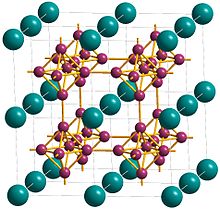Erbium hexaboride

| |
| Identifiers | |
|---|---|
3D model (JSmol)
|
|
| ChemSpider | |
| ECHA InfoCard | 100.031.775 |
| EC Number |
|
CompTox Dashboard (EPA)
|
|
| |
| |
| Properties | |
| B6Er | |
| Molar mass | 232.12 g·mol−1 |
| Related compounds | |
Related compounds
|
Erbium tetraboride |
Except where otherwise noted, data are given for materials in their standard state (at 25 °C [77 °F], 100 kPa).
| |
Erbium hexaboride (ErB6) is a rare-earth hexaboride compound containing the element erbium, which has a calcium hexaboride crystal structure.
It is one of the fundamental compounds formed in reactions between erbium and boron. The compound is isostructural with all other reported rare-earth hexaboride compounds including lanthanum hexaboride, samarium hexaboride, and cerium hexaboride.[1] Due to the isostructural nature of the rare-earth hexaborides and the strong interaction of boron octahedra within the crystal, these compounds show a high degree of lattice matching which suggests the possibility of doping by substituting one rare earth metal within the crystal with another.[2][3] Until recently, it had been hypothesized that erbium hexaboride was unstable due to the small size of the Er3+ cation within the crystal structure when compared to the ionic radii of other rare-earth elements that form known rare-earth hexaboride compounds.[4] It has now been demonstrated, however, that new nanoscale synthetic methods are capable of producing high-purity, stable erbium hexaboride nanowires. These wires, produced using chemical vapor deposition (CVD), have a reported lattice constant of 4.1 Å.[5]
References
- ^ Samsonov, Grigorii (1965). High-Temperature Compounds of Rare Earth Metals with Nonmetals. New York: Consultants Bureau.
- ^ Schmidt, P. H.; Joy, D. C. (1978). "Low Work Function Electron Emitter Hexaborides". Journal of Vacuum Science and Technology. 15 (6): 1809–1810. Bibcode:1978JVST...15.1809S. doi:10.1116/1.569847.
- ^ Tarascon, J. M.; Y. Isikawa; B. Chevalier; J. Etoumeau; P. Hagenmuller; M. Kasaya (1980). "Valence Transition of Samarium in Hexaboride Solid Solutions Sm1−xMxB6 (M = Yb2+, Sr2+, La3+, Y3+, Th4+)". Journal de Physique. 41 (10): 1135–1140. doi:10.1051/jphys:0198000410100113500.
- ^ Mar, R. W. (1973). "Conditions for Formation of ErB6". Journal of the American Ceramic Society. 56 (5): 275–278. doi:10.1111/j.1151-2916.1973.tb12487.x.
- ^ Gernhart, Zane; R. M. Jacobberger; L. Wang; J. R. Brewer; M. A. Dar; D. R. Diercks; W. N. Mei; C. L. Cheung (December 2012). "Existence of Erbium Hexaboride Nanowires". Journal of the American Ceramic Society. 95 (12): 3992–3996. doi:10.1111/j.1551-2916.2012.05427.x.